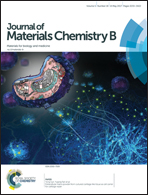Indocyanine green-functionalized bottle brushes of poly(2-oxazoline) on cellulose nanocrystals for photothermal cancer therapy†
Abstract
Deriving from the most abundant and renewable material, cellulose nanocrystals (CNCs) have drawn increasing attention in nanomedicine as well as other biomedical fields due to their excellent physicochemical properties and unique rod-like geometry. In this work, we report an efficient procedure to create biocompatible poly(2-oxazoline)s with a defined bottle brush architecture on CNCs through UV-induced photopolymerization and subsequent living cationic ring-opening polymerization. Characterization of the poly(2-oxazoline) modified CNCs indicates an improved thermal stability with the crystalline structure as well as the rod-like contour intact. The side chain terminal piperidinium of the bottle brush was utilized to immobilize indocyanine green (ICG) via electrostatic interactions. The resulting nanorods exhibit low toxicity in the dark and an efficient photothermal therapeutic effect against HeLa cells under 808 nm near infrared laser irradiation after being internalized by cancer cells. Moreover, bottle brushes on CNCs with amphiphilic poly(2-n-propyl-2-oxazoline) side chains show a higher efficiency in stabilizing ICG in comparison to those with hydrophilic poly(2-methyl-2-oxazoline) side chains, thus a higher photostability and a greater therapeutic effect were revealed for amphiphilic polymer modified CNCs. This work indicates that poly(2-oxazoline) functionalized CNCs represent a novel and promising platform for the design of other CNC-based drug delivery systems.



 Please wait while we load your content...
Please wait while we load your content...